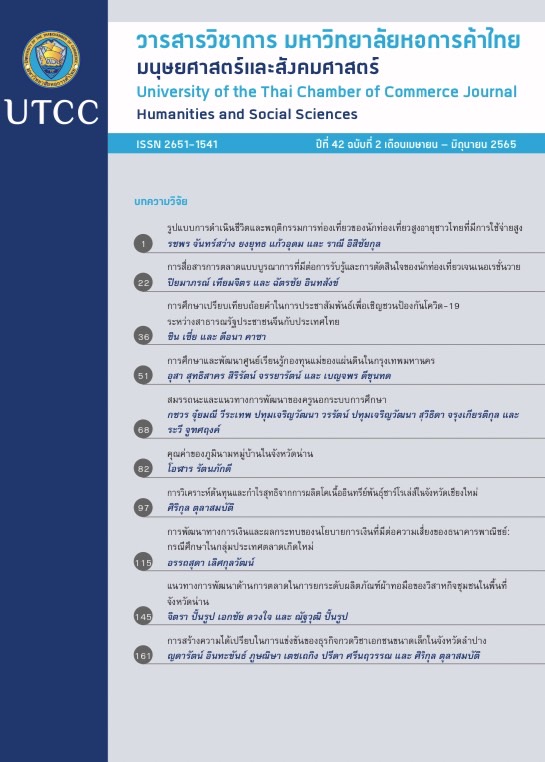การสื่อสารการตลาดแบบบูรณาการที่มีต่อการรับรู้และการตัดสินใจของนักท่องเที่ยวเจนเนอเรชั่นวาย
Main Article Content
บทคัดย่อ
การวิจัยครั้งนี้มีวัตถุประสงค์เพื่อสำรวจอิทธิพลของการสื่อสารการตลาดออฟไลน์และออนไลน์ที่ส่งผลต่อการรับรู้และนำไปสู่การตัดสินใจของนักท่องเที่ยวเจนเนอเรชั่นวาย จังหวัดนครราชสีมา การเก็บรวบรวมข้อมูลโดยการสำรวจจากนักท่องเที่ยวเจนเนอเรชั่นวาย จำนวน 392 คน โดยใช้แบบสอบถามเป็นเครื่องมือในการวิจัย ซึ่งผ่านการตรวจสอบคุณภาพของเครื่องมือด้วยการทดสอบความเที่ยงตรงเชิงเนื้อหาด้วยผู้เชี่ยวชาญและการทดสอบทางสถิติด้วยค่าอำนาจจำแนก มีค่าระหว่าง 0.702 - 0.882 และความเชื่อมั่นด้วยการทดสอบค่าสัมประสิทธิ์แอลฟาของครอนบาค มีค่าระหว่าง 0.825 - 0.901 ผลการวิจัย พบว่า ระดับความคิดเห็นของการสื่อสารการตลาดแบบออฟไลน์และการสื่อสารการตลาดแบบออนไลน์ ทุกปัจจัยแสดงในระดับมาก นอกจากนี้ ผลการทดสอบสมมติฐาน พบว่า แต่ละมิติของการสื่อสารการตลาดแบบบูรณาการ (การสื่อสารการตลาดแบบออฟไลน์และแบบออนไลน์) มีความสำคัญและส่งผลกระทบเชิงบวกต่อการรับรู้ของนักท่องเที่ยว ในขณะเดียวกันการรับรู้นำไปสู่การตัดสินใจของนักท่องเที่ยวเจนเนอเรชั่นวาย จังหวัดนครราชสีมา
Article Details

อนุญาตภายใต้เงื่อนไข Creative Commons Attribution-NonCommercial-NoDerivatives 4.0 International License.
ลิขสิทธิ์ของบทความ
ผลงานที่ได้รับการตีพิมพ์ถือเป็นลิขสิทธิ์ของมหาวิทยาลัยหอการค้าไทย ห้ามมิให้นำเนื้อหา ทัศนะ หรือข้อคิดเห็นใด ๆ ของผลงานไปทำซ้ำ ดัดแปลง หรือเผยแพร่ ไม่ว่าทั้งหมดหรือบางส่วนโดยไม่ได้รับอนุญาตเป็นลายลักษณ์อักษรจากมหาวิทยาลัยหอการค้าไทยก่อน
เอกสารอ้างอิง
กระทรวงการท่องเที่ยวและกีฬา. (2562). ยุทธศาสตร์กระทรวงการท่องเที่ยวและกีฬา ฉบับที่ 4 (พ.ศ. 2560-2564). กรุงเทพฯ: สำนักงานปลัดกระทรวงการท่องเที่ยวและกีฬา, กองยุทธศาสตร์และแผนงาน.
เกตุวดี สมบรูณ์ทวี, คมกริช ศรีไพรงาม, และลลิตภัทร สร้างถิ่น. (2561). ปัจจัยด้านคุณภาพที่ส่งผลต่อการตัดสินใจซื้อรถยนต์สัญชาติญี่ปุ่น. วารสารการจัดการมหาวิทยาลัยวลัยลักษณ์, 7(1), 1-8.
ฉัตรชัย อินทสังข์ (2562). หลักการตลาด (พิมพ์ครั้งที่ 2). นครราชสีมา: เอ็กปริ้นติ้ง.
ธนรัช เสมอภาค. (2564). การรับรู้สื่อโฆษณาที่มีผลต่อการตัดสินใจซื้อของผู้บริโภคในจังหวัดภูเก็ต. วารสารมนุษยศาสตร์และสังคมศาสตร์ มหาวิทยาลัยราชพฤกษ์, 7(1), 285-298.
ธนินท์รัฐ รัตนพงศ์ภิญโญ. (2559). ความสำเร็จของธุรกิจท้องถิ่นด้วยการจัดการนวัตกรรมและการประยุกต์ใช้สื่อสังคมออนไลน์. วารสารวิชาการ มหาวิทยาลัยหอการค้าไทย มนุษยศาสตร์และสังคมศาสตร์, 36(3), 113-125.
ธัญรัตน์ รัตนกุล. (2559). การสื่อสารทางการตลาดและการรับรู้ภาพลักษณ์ตราสินค้าที่ส่งผลต่อการตัดสินใจซื้อชุดชั้นในยี่ห้อวาโก้ของสตรีในเขตกรุงเทพมหานคร (วิทยานิพนธ์ปริญญามหาบัณฑิต ไม่ได้ตีพิมพ์). มหาวิทยาลัยกรุงเทพ.
ปราโมทย์ ยอดแก้ว. (2564). การตลาดดิจิทัลกับการเปลี่ยนแปลงวิถีชีวิตใหม่ในสังคมไทย. วารสารสังคมวิจัยและพัฒนา, 3(1), 11-22.
ปริษฐา ถนอมเวช. (2563). เครื่องมือการสื่อสารการตลาดผลิตภัณฑ์สมุนไพรกับค่านิยมของผู้บริโภควัยรุ่นยุคดิจิทัล.วารสารมนุษยศาสตร์และสังคมศาสตร์ มหาวิทยาลัยธนบุรี, 14(3), 97-106.
รุ่งนภา บริพนธ์มงคล, และกฤษดา เชียรวัฒนสุข. (2563). การรับรู้คุณภาพสินค้าและคุณภาพการบริการที่ส่งผลต่อการตัดสินใจซื้อซ้ำเครื่องทำความสะอาดอุตสาหกรรม. วารสารศิลปะและการจัดการ, 4(1), 166-179.
รุ่งโรจน์ สงสระบุญ. (2564). ตัวชี้วัดความสำเร็จของการใช้บริการแอปพลิเคชันสั่งอาหารในช่วงการระบาดของเชื้อไวรัสโคโรนา 2019 (COVID-19), วารสารบริหารธุรกิจเทคโนโลยีมหานคร, 17(2), 114-129.
เรวดี พานิช. (2559). พฤติกรรมการใช้สื่อสังคมออนไลน์ของคณะเศรษฐศาสตร์ มหาวิทยาลัยหอการค้าไทย. วารสารวิชาการ มหาวิทยาลัยหอการค้าไทย มนุษยศาสตร์และสังคมศาสตร์, 36(3), 79-93.
วนิดา เลิศพิพัฒนานนท์. (2561). รูปแบบพฤติกรรมและแรงจูงใจในการท่องเที่ยวของคนไทย Gen Y. วารสารวิทยาลัยดุสิตธานี, 12(พิเศษ), 134-149.
วรญา วิทูวินิต. (2563). อิทธิพลของการสื่อสารการตลาดแบบบูรณาการที่มีผลต่อการตัดสินใจซื้อสินค้าฮาลาลในมุมมองของผู้บริโภค Generation ต่าง ๆ ในเขตกรุงเทพมหานคร. วารสารวิทยาลัยดุสิตธานี, 14(1), 349-363.
วิลาส ฉ่ำเลิศวัฒน์. (2559). Re: digital การตลาดยุคใหม่เจาะใจลูกค้า. กรุงเทพฯ: โปรวิชั่น.
สุวิมล ติรกานันท์. (2555). ระเบียบวิธีการวิจัยทางสังคมศาสตร์: แนวทางสู่การปฎิบัติ. กรุงเทพฯ: จุฬาลงกรณ์มหาวิทยาลัย.
เสาวลักษณ์ นัทธีศรี. (2560). การสื่อสารการตลาดดิจิทัล: กลยุทธ์การบริหารเพื่อสร้างความได้เปรียบ ของสถาบันอุดมศึกษาไทย. วารสารมหาวิทยาลัยคริสเตียน, 23(2), 310-321.
เหมสุดา สันติมิตร. (2558). กลยุทธ์การสื่อสารทางการตลาดแบบบูรณาการสำหรับผู้ประกอบการธุรกิจรถจักรยานยนตบิ๊กไบค์ในเขตกรุงเทพมหานคร(วิทยานิพนธ์ปริญญามหาบัณฑิต ไม่ได้ตีพิมพ์). มหาวิทยาลัยศิลปากร, กรุงเทพฯ.
Blakeman, R. (2018). Integrated marketing communication: Creative strategy from idea implementation. Lanham, MD.: Rowman & Littlefield.
Cochran, W. G. (1977). Sampling techniques (3rd ed). New York: John Wilay & Sons.
Cooper, D. R., & Schindler, P. S. (2006). Business research methods (9 th ed). Boston, MA.: McGraw-Hill Irwin.
Hair, J.F., Black, W.C., Babin, B.J., & Anderson, R.E. (2010). Multivariate data analysis: A global perspective (7th ed.). Upper Saddle River, N.J.: Pearson/Prentice-Hall.
Key, T. M. & Czaplewski, A. J. (2017). Upstream social marketing strategy: An integrated marketing communications approach. Business Horizons, 60(3), 325-333.
Kitchen, P., & Tourky, M. E. (2020). Communications at a crossroads: what place for integrated marketing communications in a post-Covid-19 landscape?. Revista de Estudios Empresariales. Segunda Época, 2, 7-17.
Kusa, A., & Patik, L. (2021). Changes in corporate strategies and consumer behavior caused by COVID-19 affecting marketing communications and their tools. Ad Alta: Journal of Interdisciplinary Research, 11(1), 231-238.
Mihart, C. (2012). Impact of integrated marketing communication on consumer behaviour: Effects on consumer decision-making process. International Journal of Marketing Studies, 4(2), 121.
Naumovska, L. (2017). Marketing communication strategies for generation Y–millennials. Business Management and Strategy, 8(1), 123-133.
Ponte, E. B., Carvajal-Trujillo, E., & Escobar-Rodríguez, T. (2015). Influence of trust and perceived value on the intention to purchase travel online: Integrating the effects of assurance on trust antecedents. Tourism Management, 47, 286-302.
Tajvidi, R., & Karami, A. (2017). The effect of social media on firm performance. Computers in Human Behavior, 115, 1-10.
Vernuccio., M. (2015). Online and offline integration in marketing communication. Delving into the business perspective. EMAC 2015 Conference, 1-7. Retrieved from https://core.ac.uk/download/54520789.pdf


